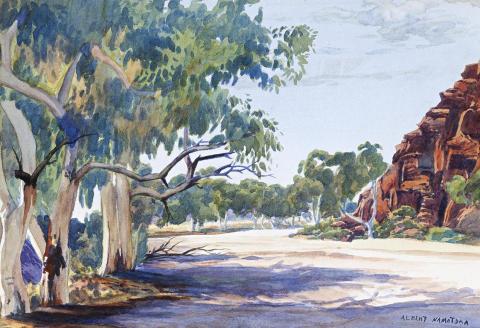THE BEND OF THE TODD, HEAVITREE GAP, 1958
ALBERT NAMATJIRA
watercolour on paper
39.0 x 56.5 cm
signed lower right: ALBERT NAMATJIRA
bears inscription verso: “The Bend of the Todd” / Heavatree [sic] Gap / Central Aust. 1958
Private collection, Canberra, acquired c.1961
Thence by descent
Private collection, Canberra
Having been maligned within the history of Australian art, Albert Namatjira is now understood to have created visions of the grand antipodean outback which have contributed as much to the creation (and reflection) of a national iconography as Arthur Streeton’s golden sun-drenched fields and Fred Williams’ tachiste landscapes. A Western Aranda man, whose childhood and early adolescence was shaped by the Lutheran Hermannsburg mission, Namatjira painted watercolour landscapes of the red centre, imbuing their geological formations with the spiritual and mythological significance that came from the dreaming of his language group of the Western Arrente, Central Desert region. However, for much of his life, Namatjira’s proficiency as a landscape watercolourist in the European style he learnt from the artist Rex Battarbee, was seen as evidence of the success of assimilation policies.
The Bend of the Todd, Heavitree Gap, 1958 is a quintessential Namatjira view of the dried-out riverbed of the Todd River, which ran through Ntaripe, a gap in the McDonnell Ranges that provided a Southern entrance to Alice Springs. It features the jewel-like tones and delicate textures typical of Namatjira’s hand, applied to discrete topographical entities of his father’s country. Using his familiarity with a camera’s viewfinder, Namatjira was able to create tightly cropped and carefully observed compositions often framed by ghost gums, featuring an astonishing depth of field, stretching as far as the eye can see.
A standing guard of ghost gums in the foreground of this painting draws the viewer’s eye through the meandering bends of the riverbed toward the deep tonal contrast provided by the iron-rich monolith’s rock face. Namatjira was a naturalist and a tonalist, whose patrilineal totemic connection to the sites of the Central Desert formed the bedrock of his art and provided plural meanings for those viewers who could read them. Wenten Rubuntja, artist and Chairman of the Aboriginal Areas Protection Authority in Mparntwe, where Namatjira lived, explained the sensitivity to plural meanings required in the appreciation of his artworks: ‘we’re not photographers, taking pictures. The country has got sacred sites, that stone, that mountain has got Dreaming and himself is sacred country. Not just free mountain. We sing that one – we got that song. Well, the song is the history of the country. […] Albert Namatjira used whitefella’s side of the story – he painted landscape. He painted the Twerrenge (Dreaming) side there as well. Namatjira used two Laws’.1
1. Rubuntja, W. cited in French, A., ‘We’ve Got to Follow that Old Man’s Tracks: Engaging with the Art of Albert Namatjira’, in Perkins, H. and West, M., One Sun One Moon: Aboriginal Art in Australia, Art Gallery of New South Wales, Sydney, 2007, p. 159
LUCIE REEVES-SMITH
